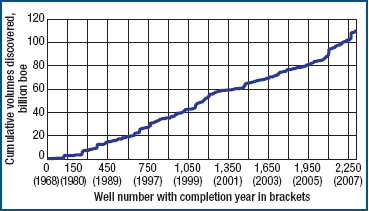DEEPWATER STATISTICAL REPORT
Global deepwater creaming curve
Explorers often use creaming curves-plots of cumulative volumes discovered versus cumulative wells drilled-to inform them of the relative maturity of a particular play or basin. In this article, we consider the creaming curve for the global deepwater plays, and look for any signs that the global deepwater opportunity is maturing.On first examination there appears to be very little that is mature about the deepwater areas. Since the first deepwater discovery was made in the Philippines in the mid-1970s, over 100 billion boe have been discovered in water depths greater than 400 m.
To date, an average volume of just under 50 million boe has been discovered by deepwater wells. The implications of the creaming curve seem to be that this average can be maintained. Indeed, the average volume per well over the last 100 wells has been in excess of 100 million boe.

Critical to the ongoing prospectivity of the deep water is the continued emergence of new deepwater plays. The most recent example of this can be seen with the “presalt” play offshore Brazil in the Santos Basin, which has delivered the largest deepwater discoveries to date.
The impact of the early discoveries in the Campos Basin and in the Gulf of Mexico can be seen in the mid-1980s, as can the boost given by the first West African discoveries in the mid-1990s, and by some of the emerging basins in the Asia-Pacific region in the early part of this decade.
So what does the creaming curve imply for the future of deepwater exploration?
The basins with the largest deepwater volumes have so far delivered around 15 billion boe. Many newly proven plays have opened in basins with much lower volumes, and we should expect further discoveries in these areas.
Over a longer period, the continued success of deepwater exploration will depend on the emergence of new deepwater plays. These are likely to include deeply buried reservoirs in the proven deepwater basins of West Africa, as well as the deepwater extensions of proven basins in North Africa and Southeast Asia. Improved industry access to areas that are presently restricted (such as the Mexican sector of the Gulf of Mexico) may also contribute to future deepwater success. 
|



